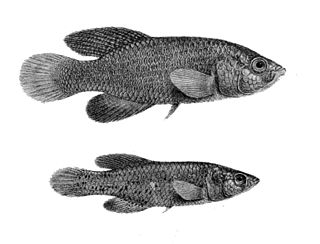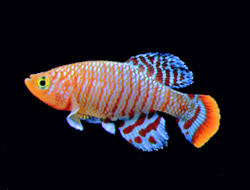
Nothobranchius is a genus of small, freshwater killifish, classified in the family Nothobranchiidae in the order Cyprinodontiformes. There are about a hundred species in the genus, many with very small distributions. They are primarily native to East Africa from Sudan to northern South Africa, whereas a dozen species are found in the upper Congo River Basin; the greatest species richness is in Tanzania.
The Boji Plains nothobranch is a species of fish in the family Nothobranchiidae, endemic to the drainage of the Ewaso Nyiro in Kenya. Its natural habitat is intermittent freshwater marshes.
The elongate nothobranch is a species of killifish in the family Nothobranchiidae. It is endemic to the coastal drainages to the north west of Mombasa in Kenya. Its natural habitat is intermittent freshwater marshes and temporary pools on floodplains.

The redtail notho is a species of killifish in the family Nothobranchiidae. It is endemic to Zanzibar. Its natural habitats are intermittent rivers and intermittent freshwater marshes. The redtail notho eats mosquito larvae and other planktonic creatures. Scientists are looking at introducing the species elsewhere in Africa to help with malaria prevention.
Nothobranchius kirki, the redfin notho, is a species of killifish from the family Nothobranchiidae which is endemic to Malawi where it occurs in the drainages of Lake Malawi and Lake Chilwa. It inhabits swamps and ephemeral pools. This species can reach a length of 5 centimetres (2.0 in) TL. It can also be found in the aquarium trade. This species was described in 1969 by the South African ichthyologist Rex Jubb from types collected by R. G. Kirk, who was a fish biologist of the Agricultural Research Services part of the Ministry of Natural Resources of Malawi, from a pool adjacent to the Likangala River which forms part of the endorheic basin of Lake Chilwa in Malawi.
Nothobranchius luekei is a species of killifish in the family Nothobranchiidae. It is endemic to Tanzania. Its natural habitat is temporary pools. Its specific name honours the German aquarist Karl Heinz Lüke who was the first person to breed this species in an aquarium.
Nothobranchius ocellatus is a species of killifish in the family Nothobranchiidae. It is endemic to Tanzania. This species was described as Paranothobranchius ocellatus in 1985 by Lothar Seegers with the type locality given as being a swamp between Mtanza and the northern entrance of the Selous Game Reserve in the drainage basin of the Rufiji River north of Rufiji in eastern Tanzania.

The spotted killifish is a small, short lived species of fish, an African rivuline from the family Nothobranchiidae. These fish are native to many isolated freshwater pools located in the savannah depressions of east Africa, specifically Malawi, Mozambique, Zimbabwe, and South Africa. This species of fish occurs in ephemeral waters and killifish eggs can survive long periods of dehydration. The word killifish likely comes from the Dutch kil for kill.

The blue notho, or Patrizi's notho is a species of killifish in the family Nothobranchiidae. It is found in Kenya and Somalia. Its natural habitat is running water. The males are usually around 5.0 centimetres (2.0 in). In the aquarium the females lay their eggs on bottom peat. This species was described as Fundulus patrizii by Decio Vinciguerra in 1927 with a type locality of the Harenaga swamps, near mouth of the Juba River in southern Somalia. Vinciguerra gave this fish the specific name of patrizii in honour of the collector of the type Saverio Patrizi Naro Montoro (1902-1957), an Italian explorer, zoologist and speleologist.
Nothobranchius steinforti is a species of killifish in the family Nothobranchiidae. It is endemic to Upper Wami River drainage, Tanzania. Its natural habitat is intermittent freshwater marshes, pools and rice fields. This species was described in 1977 by Rudolf Hans Wildekamp with the type locality given as "8 kilometers from Kimamba, Tanzania". The specific name honours the Dutch aquarist Theo Steinfort who helped collect the type and bred this species in captivity, making it available to other killifish hobbyists.

The blue lyretail, also known as the Gardner's killi and formerly as the steel-blue aphyosemion, is a species of killifish. It is endemic to freshwater habitats in Nigeria and Cameroon.

Nothobranchiidae are a family of bony fishes containing roughly 300 species, also known as African rivulines. They are small killifish, usually measuring about 5 centimetres (2.0 in). They are limited to Africa, living in fresh water but being also somewhat salt-tolerant. They are also found in muddy or brackish water. Some species are kept as aquarium pets. They have frilly fins and many are brightly colored. They were formerly included in the family Aplocheilidae ; a return to that broader family has recently been suggested.
The Guinean killifish is a species of African rivuline killifish from the family Nothobranchiidae native to the African nations of Guinea, Liberia, and Sierra Leone, where it is found in savanna streams and pools. This species grows to a length of 7 cm (2.8
Nothobranchius albertinensis is a species of brightly colored seasonal killifish in the family Nothobranchiidae. This species is endemic to seasonal freshwater habitats in north-western Uganda. It is currently known from ephemeral pools and marshes associated with the Albert Nile drainage, as well as small river systems draining into the north-eastern part of Lake Albert.
Nothobranchius taiti is a species of brightly coloured seasonal killifish in the family Nothobranchiidae. It is endemic to Uganda. It is known from temporary pools and swamps formed on the seasonal floodplains of Apapi River system. The Apapi River is part of the Lake Kyoga basin in the upper Nile drainage in eastern Uganda.
Nothobranchius elucens is a species of brightly colored seasonal killifish in the family Nothobranchiidae. This species is endemic to northern Uganda. It is currently known from temporary swamps in the Achwa River system in the upper Nile drainage.
Nothobranchius flagrans is a species of brightly coloured killifish in the family Nothobranchiidae. This species is endemic to south-eastern Democratic Republic of Congo. It is currently known from temporary swamps in the Dikuluwe system in the lower Lufira River drainage.
Nothobranchius chochamandai is a species of seasonal killifish in the family Nothobranchiidae. This species is endemic to south-eastern Democratic Republic of Congo. It is known only from the area of the type locality - ephemeral marshes of the Kinikabwimba River, a tributary of Lufutishi River in the middle Luapula River drainage.
Nothobranchius milvertzi is a species of seasonal killifish in the family Nothobranchiidae. This species is endemic to northern Zambia. It is known only from the area of the type locality - ephemeral pools formed on the floodplain and in the seasonal riverbeds of the Lushiba Marsh in the Lake Mweru basin, Luapula Province, northern Zambia.
Nothobranchius hoermanni is a species of brightly colored seasonal killifish in the family Nothobranchiidae. This species is endemic to seasonal freshwater habitats in central Tanzania. It is currently known from ephemeral pools and marshes associated with the Mhwala system in the upper Wembere drainage, as well as the Wala system, a tributary of the Malagarasi drainage. The type locality is associated with the headwaters of the Mhwala system.






